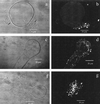Adhesion of acinetobacter venetianus to diesel fuel droplets studied with In situ electrochemical and molecular probes
- PMID: 10223998
- PMCID: PMC91295
- DOI: 10.1128/AEM.65.5.2041-2048.1999
Adhesion of acinetobacter venetianus to diesel fuel droplets studied with In situ electrochemical and molecular probes
Abstract
The adhesion of a recently described species, Acinetobacter venetianus VE-C3 (F. Di Cello, M. Pepi, F. Baldi, and R. Fani, Res. Microbiol. 148:237-249, 1997), to diesel fuel (a mixture of C12 to C28 n-alkanes) and n-hexadecane was studied and compared to that of Acinetobacter sp. strain RAG-1, which is known to excrete the emulsifying lipopolysaccharide, emulsan. Oxygen consumption rates, biomass, cell hydrophobicity, electrophoretic mobility, and zeta potential were measured for the two strains. The dropping-mercury electrode (DME) was used as an in situ adhesion sensor. In seawater, RAG-1 was hydrophobic, with an electrophoretic mobility (&mgr;) of -0.38 x 10(-8) m2 V-1 s-1 and zeta potential (zeta) of -4.9 mV, while VE-C3 was hydrophilic, with &mgr; of -0.81 x 10(-8) m2 V-1 s-1 and zeta of -10.5 mV. The microbial adhesion to hydrocarbon (MATH) test showed that RAG-1 was always hydrophobic whereas the hydrophilic VE-C3 strain became hydrophobic only after exposure to n-alkanes. Adhesion of VE-C3 cells to diesel fuel was partly due to the production of capsular polysaccharides (CPS), which were stained with the lectin concanavalin A (ConA) conjugated to fluorescein isothiocyanate and observed in situ by confocal microscopy. The emulsan from RAG-1, which was negative to ConA, was stained with Nile Red fluorochrome instead. Confocal microscope observations at different times showed that VE-C3 underwent two types of adhesion: (i) cell-to-cell interactions, preceding the cell adhesion to the n-alkane, and (ii) incorporation of nanodroplets of n-alkane into the hydrophilic CPS to form a more hydrophobic polysaccharide-n-alkane matrix surrounding the cell wall. The incorporation of n-alkanes as nanodroplets into the CPS of VE-C3 cells might ensure the partitioning of the bulk apolar phase between the aqueous medium and the outer cell membrane and thus sustain a continuous growth rate over a prolonged period.
Figures







References
-
- Baldi F, Minacci A, Saliot A, Mejanelle L, Mozetic̆ P, Turk V, Malej A. Cell lysis and release of particulate polysaccharides in extensive marine mucilage assessed by lipid biomarkers and molecular probes. Mar Ecol Prog Ser. 1997;153:45–57.
-
- Baldi F, Pepi M, Fani R, Di Cello F, Da Ros L, Fossato V U. Complementary degradation of fuel oil in superficial waters and in axenic cultures of aerobic Gram-negative bacteria isolated from Venice Lagoon. Croat Chem Acta. 1997;70:333–346.
-
- Barradas R G, Kimmerle F M. Effect of highly surface-active compounds on polarographic electrode processes. J Electroanal Chem. 1966;11:163–170.
-
- Bradford M M. A rapid and sensitive method for quantitation of microgram quantities of protein utilizing the principle of protein-dye binding. Anal Biochem. 1976;72:248–254. - PubMed
LinkOut - more resources
Full Text Sources
Molecular Biology Databases
Miscellaneous

